Today in Tedium: Today is a sad day in adhesive history, as the U.S. Postal Service, apparently because they don’t have any taste whatsoever, is killing something cool that was sold under their purview—self-adhesive stamps that feature custom imagery. Barring an 11th-hour reprieve, Stamps.com will stop selling the stamps, known as PhotoStamps, for the USPS after Wednesday, because the Postal Service was apparently afraid of the competition? Who knows—it’s a bad decision, and it sucks for fans of customization. In honor of what those stamps represented, today’s Tedium is going to spend a little time pondering labels, stamps, and other adhesive products. Stick around. — Ernie @ Tedium
Keep Us Moving! Tedium takes a lot of time to work on and snark wise about. If you want to help us out, we have a Patreon page where you can donate. Keep the issues coming!
We accept advertising, too! Check out this page to learn more.
1964
The year that the self-adhesive stamp, first came into use in Sierra Leone. First presented at the 1964 World’s Fair, the stamps were also die-cut to match the shape of the country. There was a practical reason for using these stamps—they made the stamps easier to store in tropical climates—but they created a problem for stamp collectors, as Linn’s Stamp News explained in 2002: “Collectors, however, had mixed reactions. After all, what were they to do with these strange stamps? Mint stamps would be difficult to mount. They would obviously have to be kept on their liner paper. And what long-term effect would this self-adhesive gum have on the stamps’ condition? Collectors of used stamps were as baffled. Real-life experience quickly showed that these stamps were impossible to soak from paper.”

Our laptops wouldn’t look quite the same without this invention. (Melissa Keizer/Unsplash)
The guy who turned a $100 loan from his fiancé into an adhesive giant … after a name change
These days, as people are stuck at home trying to get some dang work done, many of those folks have stickers on the back of their laptops. Some of them are quite creative and clever; many of them never get removed, of course.
(I thought the design of my HP Spectre x360 was simply too lovely to add any stickers to, but on my MacBook Pro, I have the warning label commonly seen on the back of NES games—you know the one, the one that warns not to immerse the game in water.)
In many ways, the roots of how we got all these stickers on our laptops comes down to a guy named Ray Stanton Avery. Avery was known as a tinkerer while a student at Ponoma College, and had a great interest in a printing press that his father, a minister, used to print sermons and church bulletins.
According to his entry in Oxford University’s American National Biography Avery had experimented with ideas such as a phonograph with a built-in alarm clock, which led to a role with an on-campus firm that produced its own primitive self-adhesive labels. Avery was brought in to improve the machinery used to create those labels. (One technique he used involved a cigar box with holes cut out of it to allow for the application of adhesive to the back of a sheet of paper.)
The company failed, but he kept experimenting with the ideas, thanks to $100 in seed money he received from from Dorothy Durfee, a schoolteacher who later became his wife. (His second wife, apparently, as when I was researching this I found an article suggesting he was married once before—something not mentioned in prior biographies!)
Avery’s goal was to come up with an easier way for stores to price products, by putting easy-to-remove labels on the objects.
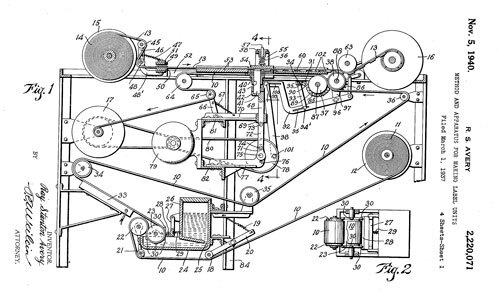
The self-adhesive machine invented by Avery. (Google Patents)
Combining various cast-off parts, including a motor from a washing machine and a saber saw, Avery managed to build a method for labels that were both self-adhesive and die-cut, making them both more efficient and easier to use than other types of labels common at the time.
In his 1937 patent filing explaining the benefit of the approach:
In order to provide labels which can readily be affixed to all kinds of surfaces, and yet be easily removed without leaving marks or otherwise damaging said surfaces, the present invention contemplates the application of a pressure sensitive adhesive surface on the labels. Such adhesive surfaces are characterized by the fact that they do not require moistening prior to their application, but are affixed to a surface by slight application of pressure, and are readily removable by peeling from engagement with the surface to which they are adhesively affixed.
The name that Avery chose for his company that created this obviously quite important line of labels? Kum Kleen Products. (He was an inventor, not a branding expert!)
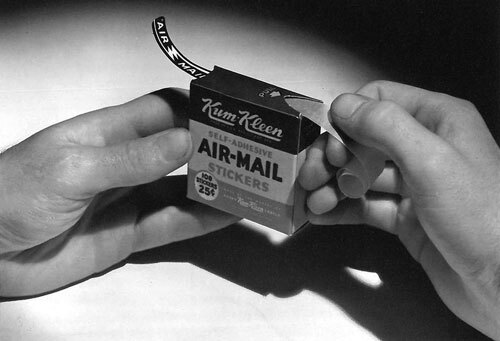
Did they not have any self-awareness in the 1930s? (via Avery Denison)
Fortunately, Avery had the good sense to change the name to Avery Adhesives, a firm that revolutionized labeling over the next 50 years, gaining use in things as varied as stickers, postage stamps, product labels, and numerous other things. By being able to apply pressure to affix a label rather than by moistening the surface as one might do with a vintage stamp, it made the adhesives easier to manage and more foolproof.
Avery’s namesake company, now known as the adhesive manufacturing company Avery Dennison, has been around for decades, mostly focused on packaging, retail labeling, and industrial use cases. But you probably know the Avery name because of the fact that the company moved into office-supply products, mostly adhesives, starting in the 1980s.
These labels took advantage of the fact that printers were becoming increasingly common both in the office and the home, and were often printable. One common use case for the labels was to print addresses where you were going to send, say, invitations. It took half a century, but Avery’s bold idea found a perfect use case in the 1980s.
You can probably credit Ray Stanton Avery for the rise of the “Hello my name is …” badge.
Avery Products Corporation, the label-making subsidiary, was eventually sold off from Avery Denison, but is still active today, producing labels that you put on letters, perhaps, or on boxes, or on floppy disks. (Maybe even CD-ROMs? More on that in a second.) They, along with competitors such as 3M, were fairly ubiquitous throughout the 1980s and 1990s, only falling out of favor to a degree because of the fact that we rely on computers to label things now, no printer required.
These days, the company offers custom-printing services for those who want something nicer than a mere inkjet printer can produce.
“It was part of my job as a researcher to develop new adhesives, and At that time we wanted to develop bigger, stronger, tougher adhesives. This was none of those.”
— Dr. Spencer Silver, a 3M scientist, discussing the surprisingly weak adhesive that he discovered in 1968, which barely even stuck on things. Silver’s discovery of this adhesive seemed fairly useless for years, until he figured out that it was the perfect thing to put on paper that could be easily removed. Voilà—this is how we got the Post-It Note.

Neato CD labels were often pulled out when a mix disc needed a touch of graphic design.
Neato idea: How an entrepreneur focused on patents turned CD labeling into a big business
Doing the heyday of the CD-ROM, many of the resources we take advantage of in an at-your-fingertips-over-the-internet form now existed only in physical mediums.
But some of that data is incredibly niche, only needing a few copies to go out into the world, rather than thousands. Which means that it may be cost-effective to burn a CD, but using a professional printing process to put a design on it—say, silk-screening it—doesn’t make much sense. Perhaps if you were selling millions of copies of Microsoft Encarta, you could swing it, but when you’re producing discs by the dozens, it probably makes no sense.
This was the problem that a firm that MicroPatent, which resold U.S. Patent Office data to companies on CD-ROM, ran into as it tried to leverage the lower costs of manufacturing CD-Rs onsite. Putting labeling on compact discs proved a unique challenge, for a few reasons: One, compact discs have giant holes in the middle; two, it’s easy to make a mistake when putting an adhesive on the disc; and three, discs with improperly applied labeling can create problems for CD players, especially motorized ones that suck CDs in, and screwing up the labeling process could get pretty awkward.
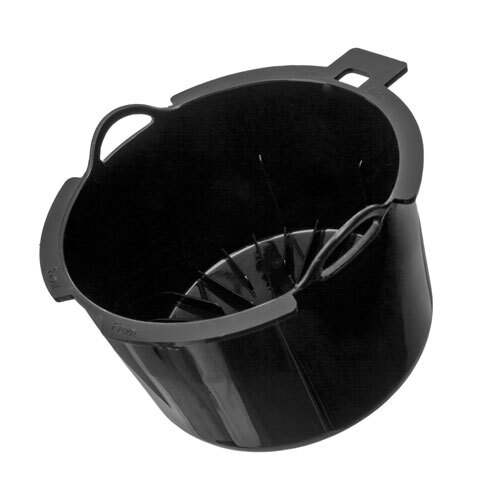
When in doubt, use a Mr. Coffee brew basket.
Enter the Mr. Coffee machine. According to the Hartford Courant, a coffee maker filter holder was MicroPatent’s big solution to the label conundrum that the company faced, with the filter holder essentially working as an applicator to put a label onto the disc perfectly every single time. MicroPatent die-cut labels that could be printed onto with an inkjet or laser printer, and boom—no silk-screening needed.
Soon enough, and this process was formalized into an actual device for sale—the Neato CD label applicator, a familiar device to anyone who wanted to give their CDs a unique design on the cheap. It solved all of the above problems by making the placement of the adhesive label on the disc nearly fool-proof—something increasingly important given the increasing speeds of CD-ROM and DVD drives of the time.
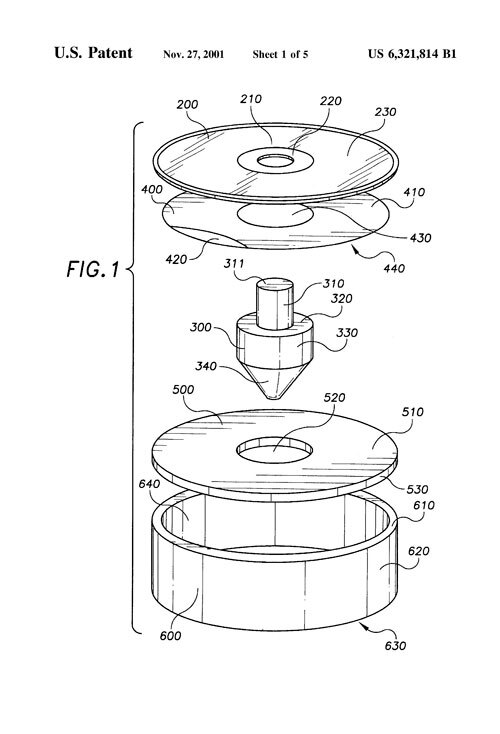
This device is either extremely familiar to you, or it’s the first time you’re ever seeing it. (Google Patents)
“Improper placement of a label on a disk, especially with the advent of high speed, e.g., ten or higher speed data transfer (with single speed data transfer defined as the rate necessary to support CD audio), and higher information density disk recording technologies, such as Digital Video Disk (‘DVD’), may result in read errors, or drive motor damage due to dynamic imbalance of the disk,” stated Neato LLC’s patent for a “disk labeling device.” (MicroPatent didn’t just republish patents, they added their own.)
Peter Tracy, the founder of MicroPatent and Neato, noted to the Hartford Courant in 2001, that the label maker became an accidental business of sorts, one that he turned his attention to in full around 1997 after selling off MicroPatent.
“Up until then, I hadn’t paid much attention to Neato,” he told the newspaper. “I had intended to retire and play music. But I couldn’t stop answering the phone, and the phone would not stop ringing for this product.”
Initially showing up in magazine ads, the firm later teamed with the office supplied firm Fellowes, which helped the Neato product have reach in office-supply and big-box stores around the country. Neato later expanded beyond CD labels to other commonly labeled forms of media, and exists to this day, largely printing custom labels for things.
Along the way, the company made tens of millions of dollars per year at its height, with the $30 kits, which were widely considered the most foolproof way of getting a printed label onto a CD manually, helping to turn wedding photo galleries and mix discs into truly special things.
Sure, they drew lots of competitors, among them the aforementioned Avery, which also got into the CD-labeling business in the ’90s, but their solution was the most novel and memorable.
Not bad for a device inspired by a coffee-maker.
1946
The year that Forest Gill, a Kansas print shop owner, combined the self-adhesive concepts perfected by Avery with another type of World War II-era technology that was brand-new at the time—day-glo ink, which was highly visible in normal light conditions—to create the modern bumper sticker. By the 1960s, as The Atlantic notes, the bumper sticker had gained prominence with politicians, which effectively turned car bumpers around the world into tiny billboards.
Back to the custom stamps to-do I mentioned at the beginning. In the late 1990s, a series of companies came out with products that effectively allowed people sending mail to use their printers to put postage on envelopes, stickers, or whatever else, getting access to stamps by buying them over the internet. It was an unprecedented move at the time, but one that proved to be one of the smartest moves in the recent history of the U.S. Postal Service.
“Our goal is to postage-enable every Internet-connected desktop and to provide a secure electronic commerce platform for postal services for the 21st century,” said Nicole Eagan of the firm E-Stamps, one of the first firms to get USPS approval to sell stamps in this way, in comments to Network World.
E-Stamps didn’t stick around, but one of its competitors of the era very much did. That company, Stamps.com, is at the center of the current controversy over the custom stamps, which is an unfortunate controversy, because it appears the USPS is screwing over a business partner at a time when USPS can’t afford to screw over a business partner.
The concept of PC Postage has been a fairly large money-maker for the U.S. Postal Service, generating $6 billion in revenue for USPS in 2018—not a small amount given the financial woes the agency has faced over the years.
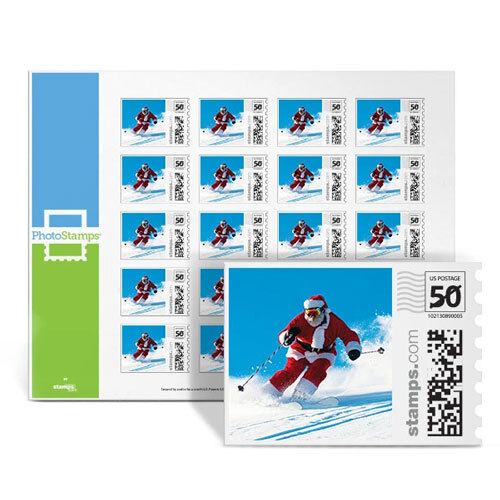
What kind of monster do you have to be to want to kill something like this?! (via PhotoStamps)
The custom stamp concept, called PhotoStamps, was introduced by Stamps.com in 2004 with the Postal Service’s support. But last month, the company revealed that PhotoStamps, despite having a consistent niche in popularity, were being shut down after 16 years.
The reasons seemed to play into USPS’ position in the culture wars. One of the things that PhotoStamps specifically banned was the use of religious insignia on the stamps, something the Postal Service had been sued over.
The Postal Service also apparently had an issue with the fact that the stamps were being purchased by people but never used (a claim Stamps.com disputes), and discouraged Stamps.com from calling the adhesive stickers “stamps.”
And while likely not directly related, John Oliver’s pitch to use PhotoStamps to help save the Post Office came right around the same time Stamps.com disclosed that the program was being shut down, which may have given the program an unwitting political edge.
But when it comes down to it, it feels like a situation in which the no-joy contingent of the U.S. Postal Service killed something cool because it was largely out of their control.
“We certainly expect to keep trying as we believe it’s a fun product that brings a lot of joy and creativity to the mailing world,” Stamps.com CEO Ken McBride told Linn’s Stamp News.
If you get a chance today, buy some custom stamps and share them with your friends and family. You won’t be able to starting tomorrow.
--
Find this one an interesting read? Share it with a pal! See you next time.






